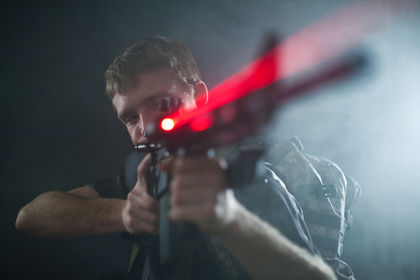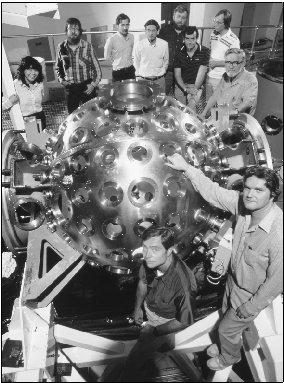Chapter 4
Military Applications of Lasers

The U.S. military became interested in lasers even before the first lasers had actually been built. When military leaders heard that the new device might produce very hot beams of light, they immediately dreamed of developing beam weapons. They hoped these weapons would do many things that ray guns had done in science fiction stories, including blasting holes through enemy soldiers and tanks or even shooting down planes and satellites.
Much of the military's early exposure to the laser idea came from Gordon Gould, the laser pioneer who had so much difficulty getting recognition for his work. Even though he was having trouble getting a patent, he continued to work on lasers; and when he left Columbia University in 1959 he went to work for Technical Research Group (TRG), a company in Syosset, New York, that did research on radar, missiles, and other military projects. Gould got TRG very interested in lasers. TRG then asked the U.S. Department of Defense for three hundred thousand dollars to do research on laser weapons. The military was so fascinated by the idea of beam weapons that it gave the company almost a million dollars, more than three times the amount that had been requested.
A few months later when Maiman built the first ruby laser, his own company, Hughes Aircraft, began working on laser weapons. Soon, various branches of the military—army, navy, and air force—gave money to several other companies to develop such weapons. Between 1962 and 1968 the army alone spent almost $9 million on laser research.

But could such death rays actually be built? The answer, at least at that time, was no. Scientists found that lasers did indeed produce very concentrated beams of light. But building the kinds of weapons the military wanted turned out to be much more difficult than everyone had figured. "So far lasers have been found to make poor weapons," says Breck Hitz, "and many scientists believe that engineering complexities and the laws of physics may prevent them from ever being particularly useful for this purpose." 4 Nevertheless some researchers are more optimistic about the potential of laser weapons, and intensive research and development continues. At the same time, the laser continues to prove highly applicable and useful in other battlefield roles such as range finding and designating targets.
Electrically Powered Laser Weapons
At present most experiments with laser-beam weapons rely on chemical mediums—such as oxygen-iodine—to produce the energy to power the laser. But the U.S. Air Force and other groups are working on the idea of carrying special generators on attack aircraft. Such generators would produce electrically powered laser weapons that utilize fiber-optic technology. Fiber optics would allow the generators to be built much smaller than the equipment needed to produce chemically powered lasers; so such a weapons system would easily fit in a small fighter plane (as opposed to a 747 freighter, which is slower and less versatile). There would also be a nearly unlimited supply of "shots" as the generators constantly produce new energy. Such weapons could be positioned on a plane's wings, ready to fire at any oncoming missiles.
A Lopsided Energy Ratio
The main difficulty faced by scientists attempting to build laser-beam weapons has been a lopsided ratio between the amount of energy needed to power the weapon and the amount the weapon produces. In the case of handheld ray guns, for example, too much energy is required for devices so small. To produce enough power such guns would have to be so huge no one could carry them. Also, the guns themselves would get very hot, hot enough to cause serious burns on the hands of the people holding them (unless they wore thick protective gloves, which would hinder operation of the weapon). Over the years, researchers repeatedly found that, for the time and money required to build them, ordinary rifles would be more effective handheld weapons than lasers.
For a long time, lasers that could shoot down planes or satellites seemed more promising. And that use of laser weapons remains the most sought-after today. A laser device capable of shooting down a missile also will need to be quite large, but this may not be an obstacle considering that it will not have to be handheld. More problematic is the nature of the lasing medium, the chemical components that produce the laser beam. The lasing mediums used back in the 1960s did not produce beams powerful enough to shoot down enemy aircraft. Later, researchers tried other lasing mediums such as a mixture of the elements fluorine and hydrogen. This produced a lot of power but had some serious problems. The mixture explodes easily and without warning, and the exhaust gas is hard to get rid of and kills anyone who breathes it. Scientists encountered many other such problems over the years.
Scoring Hits at the Speed of Light
But military leaders continued to pour money into laser weapons research. They knew that such weapons would have some clear advantages over normal bullets and missiles. In the first place, when firing a bullet at a moving target one has to aim a bit ahead of the target. This is because the target itself moves ahead while the bullet is racing toward it. Since gravity pulls the bullet downward one also has to aim a bit above the target. In the middle of a battle, with all the smoke, noise, and confusion, hitting a moving target can be a difficult task.
But a laser beam moves at the speed of light. This means that the beam can travel a mile in only six-millionths of a second. Even if an airplane were traveling at the speed of sound, it would move only about one-sixteenth of an inch during the time span in which the laser beam covered the mile. Military experts realized that more hits could be scored by laser weapons than by ordinary guns and missiles. Another potential benefit of beam weapons is that they could be bounced off mirrors, so only the mirrors would need to be moved when switching to a new target (instead of moving the whole weapon). Also, a laser beam stays concentrated over long distances, so it might be able to hit targets hundreds of miles away.
In 1973 the U.S. Army finally succeeded in shooting down a drone (a remote-controlled plane). But military leaders did not consider the test a complete success. The drone did not move as fast as enemy aircraft, and the program leading up to the test had been very expensive. In fact, laser weapons in general seemed to be almost too expensive. At that time a modern tank cost about $1 million to make; experts estimated that a battlefield laser would cost nearly $10 million. But the military still pressed on with laser experiments. By 1980 the U.S. government had spent hundreds of millions of dollars on laser research. Unfortunately, there had been only a few practical results. Looking back, many experts feel the military moved too quickly on lasers. It did not allow enough time for developing the new technology before it demanded results.
Range Finders and Bomb Designators
Still, the military has enjoyed a considerable amount of success in developing laser devices for use on the battlefield. These devices, which greatly improve the accuracy of normal conventional weapons, include range finders and bomb designators. A range finder calculates the distance, or range, to a desired target by measuring how long a small burst of laser light takes to travel to the target. This practical tool can be either handheld or mounted on a tank. Obviously, if a soldier knows the exact distance to his target, he has a much better chance of hitting it. By the mid-1970s Hughes Aircraft was building more than $50 million worth of laser range finders for the U.S. military each year.
A laser bomb designator works by shining a low-powered laser beam at the desired target. After the target has been designated, a bomb is released, either from an airplane or from a ground-based missile; this is known as a "smart" bomb because it carries a sensor that can detect the laser beam and use it to home in on and destroy the target. The military first used such devices on the battlefield in 1972 during the Vietnam War, and much improved versions proved highly successful in the Persian Gulf War (in 1991) and especially in the police action against terrorists in Afghanistan (in 2001).
Simulating Battlefield Conditions
Lasers have also proved to be successful in simulating mock battles that are staged to give soldiers practice for the real thing. Before lasers, these simulations had not been as realistic as military officials would have liked. Obviously, the soldiers on opposing teams could not really fire at each other, so referees had to decide who had or had not been "hit." Their decisions naturally involved a certain amount of human error.
In laser battle simulations, soldiers fire special guns that shoot bursts of light. Sensors are attached to each soldier who fights in the battle; such sensors are also attached to tanks, trucks, or any other vehicles used in the mock fighting. When a burst of light is fired and hits a sensor on an "enemy" soldier, the sensor registers the light and everyone knows immediately that the soldier is "dead." They know when a tank or truck has been destroyed because the sensors mounted on vehicles give off a cloud of smoke when hit. Many companies now build such battle simulators, which are used by armies all over the world.
Underwater Communications
Another dramatic use for the military laser is in the area of submarine (underwater) communications. Submarines often patrol in enemy waters, and in the past the only way an admiral could get a message to a sub was by using ordinary radio. But this has two serious disadvantages: First, radio waves do not travel well underwater and require large antennas to broadcast them long distances. Second, there is always the risk that the enemy will pick up the signal, which immediately reveals the sub's location and exposes it to danger.
For underwater use, a laser is more effective than radio because of a unique and important quality of laser light: It is monochromatic. This means that it shines in only one color ( mono means "one" and chroma means "color"). It is very different from ordinary white light, which is made up of all the colors of the rainbow bunched together.
To send a message to a submarine the navy uses a laser that gives off a monochromatic beam of blue-green light. This particular shade of blue-green travels easily through ocean water. The beam carrying the message is transmitted to a satellite orbiting high above the ocean. The satellite then relays the beam down to the sub, which is equipped with a special receiver that registers only blue-green light. In less than a second the sub's computer decodes the signal so the crew can read the message.
If there are any enemy lookouts nearby it is unlikely they will know about the signal beam, which the satellite flashes for only a few millionths of a second. This is not enough time for the lookouts to see the beam with their naked eyes. And even if they have a receiver that detects laser light, it has to be tuned to receive the exact shade of blue-green in the beam. Their receiver also has to be underwater near the sub because that is where the satellite aims the beam. Meeting these conditions would be very difficult for the lookouts, so chances are good that the sub will get the message and still remain undetected.
Research on "Star Wars" Continues
Meanwhile, the U.S. military did not give up on developing laser beam weapons. In fact, research into satellite and rocket lasers increased dramatically in the 1980s with President Ronald Reagan's call for the building of a

Despite the major difficulties of producing such weapons, a number of military leaders are optimistic that at least a modestly practical version can be built. The U.S. Air Force, for instance, is confident that its ongoing development of the so-called Airborne Laser (ABL) will result in a working weapon within four to six years. "The job of the ABL," reports military weapons observer John Tirpack,
will be to orbit the skies near the forward edge of a battle area, watching with infrared search-and-track devices for the launch of enemy . . . ballistic missiles. Once it spots one, the ABL platform—a militarized 747 freighter filled with lasers for ranging, targeting, and attack—will get a lock on the target. When the missile rises above the clouds, the ABL will focus a beam of light 15 inches in diameter on the missile's skin. The skin will heat up and rupture, causing the volatile materials inside to explode. Debris—and the missile warhead—will rain down on the nation that launched it. This, it is thought, will serve as a deterrent to the use of . . . ballistic missiles in the first place. As a bonus, the ABL will determine the launch location and then pass that information on to attack airplanes. . . . The strike aircraft can dash to the launch area and destroy other missiles on the ground before the enemy has a chance to fire them or move them to a new hiding place. 5
At present, the Star Wars defense system remains the subject of debate among scientists, politicians, military personnel, and the American public. Some scientists believe the long-term benefits of such a program are questionable and that the expense involved in implementing it is too high. Others say that Star Wars is necessary to U.S. military strategy against both hostile nations and terrorist attacks and is therefore well worth the money. Whatever the future of Star Wars, the debate is likely to continue for years to come.
There is one thing that everyone can be sure of. Lasers have found a permanent home in the arsenals of the world's armies, so research into the military use of lasers will continue. The wars of the future, as the very successful 2001 U.S. operation in Afghanistan illustrated, will be fought very differently than those of the past. One important difference is that several kinds of laser devices will be standard equipment for large numbers of soldiers, sailors, and pilots.
The world is tending towards a new order where the use of technology would ease work of our arm forces and also keep out of harms way